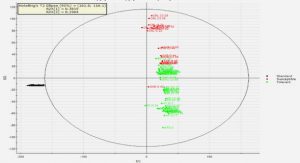Get Complete Project Material File(s) Now! »
Flotation of complex sulphide minerals
In the case of complex sulphide ore such as the Rosh Pinah ore, where galena and chalcopyrite are floated in the lead circuit, it is customary to decrease the presence of pyrite and sphalerite in the lead concentrate when flotation is carried out in mildly alkaline medium (pH 8-9). In practice, this is not always straightforward because complex ores usually behave differently from single minerals. This is due, amongst other things, to the interactions between different minerals from the same ore, between minerals and griding media, and the electrochemical conditions present in the system. A number of studies have reported that galvanic interactions between grinding media and different minerals, as well as between different minerals can affect the flotation selectivity of sulphide minerals depending on the electrochemical conditions in the mill (Mielczarski and Mielszarski, 2003; Peng et al., 2003a and b; Peng et al., 2002; Yuan et al., 1996; Natarajan, 1996; Cheng and Iwasaki, 1992; Guy and Trahar, 1985; Natarajan and Iwasaki, 1984).
Grinding in steel rod and ball mills is a common practice in minerals beneficiation. It is generally accepted that the electrochemical interactions between the grinding media and the minerals in a grinding mill influence the corrosive wear of balls/rods and the surface properties of the ground minerals (Natarajan and Iwasaki, 1984). Usually, the sulphide minerals behave like cathodes and the steel grinding media like anodes, which release iron ions into the pulp (Figure 2.4). The release of iron from the steel grinding media can have a detrimental effect on the recovery of a single mineral such as galena (Figure 2.5).
Activation of zinc sulphide minerals
Activators are generally used in the flotation of zinc sulphide minerals because these minerals do not respond well to flotation with short chain thiol collectors. Activators alter the chemical nature of the mineral surfaces so that they become more floatable after their interactions with collector. The activators are generally soluble salts, which ionise in solution and then react with the mineral surface. Heavy metal ions such as Cu2+, Pb2+, Ag2+ and Cd2+ are known to activate zinc sulphide minerals and promote their flotation with xanthate (Popov et al., 1989a,b; Ralston and Healy, 1980 a,b). When sphalerite is activated with Cu(II) ions, adsorbed Cu(II) ions are reduced to Cu(I) with oxidation of adjacent sulphide (S2- from sphalerite) to polysulphides (Gerson et al., 1999; Pattrick et al., 1999). Popov and Vucinic (1990) have also shown that Cu(I)-ethyl xanthate was the dominant surface species when sphalerite is activated by Cu(II) under flotation-related conditions. When sphalerite is activated with Pb(II) ions, it is believed that lead species adsorb on the mineral surface. The presence of colloidal lead-xanthate has been observed on the surface of lead-activated sphalerite following the addition of xanthate in solution.
The aqueous and surface chemistry of activation of sulphide minerals has been extensively discussed in the literature (Gerson et al., 1999; Pattrick et al., 1999; Prestidge et al., 1997; Laskowski et al., 1997; Kim et al., 1996; Wang et al., 1989a,b; M.C. Fuestenau, 1982; Finkelstein and Allison, 1976; and Gaudin, 1957). The electrochemistry of sphalerite activation has been investigated by Richardson et al. (1994) and Chen and Yoon (2000). Different instrumental techniques such as X-ray photoelectron spectroscopy (XPS), Auger scanning microscopy (ASM), Atomic force microscopy (AFM), Secondary ion mass spectrometry (SIMS) and X-ray absorption fine structure (XAFS) have been used for the identification of activation species. In the flotation system such as the one at Rosh Pinah concentrator, selective flotation of the lead-zinc ore can be affected by the activation and subsequent flotation of sphalerite in the lead circuit.
Activation of sphalerite by copper ions
Copper sulphate is the most common activator used for sphalerite flotation with xanthate. There is a general agreement that the mechanism of copper activation of sphalerite depends on the pH of the solution (Prestige et al., 1997; D.W. Fuerstenau, 1982; Girczys et al., 1972), due to the variation of the predominant copper species at acidic and alkaline pH values. Figure 2.8 shows the copper species that can be formed at different pH values (Huang, 2003). It can be seen that Cu2+ and Cu(OH)2 are the most predominant species at acidic and alkaline pH values, respectively. In addition, Figure 2.8 shows that the onset of Cu(OH)2 precipitation is at pH 5.6 for a total copper concentration of 10-4M.
1. Introduction
2. Background
2.1. The Rosh Pinah zinc-lead Mine
2.2. Flotation of sulphide minerals with thiol collectors
2.3. Activation of zinc sulphide minerals
2.4. Kinetics of the activation of sphalerite
2.5. Conclusion
3. Effect of free cyanide on the activation and deactivation of sphalerite
3.1. Introduction
3.2. Deactivation of sphalerite with cyanide
3.3. Effect of recirculating water on the activation of sphalerite
3.4. The electrochemical oxidation of copper-cyanide complexes
3.5. Specific relevance to the flotation at the Rosh Pinah Mine
3.6. Conclusion
4. Experimental
4.1. Materials, reagents and solutions
4.2. Flotation
4.3. X-ray photoelectron spectroscopy
4.4. Fourier transform infrared spectroscopy
4.5. Scanning electron microscopy
5. Factors affecting the flotation selectivity of galena and sphalerite
5.1. Introduction
5.2. Effect of xanthate chain length and dosages on the flotation recovery
5.3. Effect of Pb(II) and Cu(II) ions on the activation of sphalerite
5.4. Conclusion
6. Effect of cuprous cyanide, dry and wet milling on the selective flotation of galena and sphalerite
6.1. Introduction
6.2. Effect of grinding environment on the pulp chemistry and flotation
6.3. Influence of cuprous cyanide on the flotation recoveries
6.4. X-ray photoelectron spectroscopy on the activation of sphalerite
6.5. Relevance to flotation in the lead circuit at Rosh Pinah Mine
6.6. Conclusion
7. Depression of sphalerite with cyanide and zinc sulphate
7.1. Introduction
7.2. Deactivation with zinc sulphate
7.3. Deactivation with zinc sulphate and sodium cyanide
7.4. Effect of sodium cyanide on the flotation response of the Rosh Pinah composite
7.5. Effect of sodium cyanide and zinc sulphate on the flotation response of the Rosh Pinah composite
7.6. Deportment of sphalerite through the flotation products
7.7. Conclusion
8. Conclusions and recommendations
References






